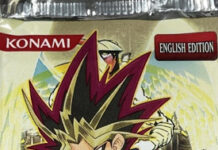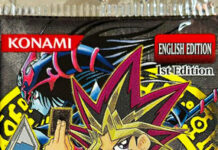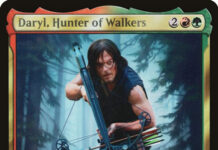We talk a lot about which colors are the easiest to make overpowered – both the community in general, and me in my recent Mystery Booster pre-reviews. But I think we need to talk just as much about which colors are the easiest to make boring. Cardmarket’s Magic YouTube channel recently posted a really good retrospective about card design since Throne of Eldraine, and they characterized the apparent new philosophy as making things exciting for casual players and dealing with tournaments with bannings and other interventions as need be. In addition to the evidence from booster contents, you’ll note that Wizards of the Coast has a habit of banning cards pre-emptively in some of Arena’s tournament formats, but leaving them available for its more casual settings and the freeform format Timeless. As it happens, I’ve believed for years that this type of casual focus would be a better way to deal with design, not least since the tournament-focused methods of the 2000s also failed to deliver balanced tournaments. But on top of that, and more importantly, most players are casual players who never go to tournaments, rarely if ever visit a local game store, and in some cases don’t know or care what all the card types are. Yet if this is the new perspective, that means we also need to think about what makes cards or sets boring.
Knowing which color is easiest to make boring is much harder than knowing which color is easiest to make broken. All colors are susceptible to the type of boring that comes from repetition – too many Counterspell variants is just as boring as too many Terror variants is just as boring as too many Lightning Bolt variants is just as boring as too many Savannah Lions variants is just as boring as too many Rampant Growth variants. The bigger question is which color is most susceptible to the type of boring that comes when its effects and abilities just aren’t exciting or interesting. This is inherently more subjective: for example, I find decks that lean too much on counterspells to be incredibly dull to play with, but some people see them as an intellectual challenge. I think this type of boring might also be linked to the different kinds of uses you can perceive for the cards in question.
If so, red is potentially highly susceptible to both types of boring. Lightning Bolt variants are very hard to distinguish meaningfully from each other, and they are also easy to perceive as only doing one thing. If you’re familiar with cube draft, you might have encountered a cube list that plays all the near-duplicate burn spells like Lightning Strike and Searing Spear just to have a critical mass, and doesn’t care about the cards beyond that. Pigeonholing direct damage is perhaps not entirely fair, as it has more strategic depth and versatility than many players realize, but the perception is hard to overcome. And it’s doubly ironic, given that red’s flavor is associated with creativity and free thinking.
Fortunately, as I said years ago in the context of the original Mystery Booster‘s playtest cards, we have recently been getting a lot of novel and exciting abilities on red cards. The rate of these abilities’ expansion has slowed compared to when I wrote that, which perhaps makes sense. They try to conserve design space, and nowadays things are more stable and more balanced in terms of the colors having interesting things to do. This also means that Mystery Booster 2‘s red playest cards are not quite as jaw-dropping as some of the original Mystery Booster‘s cards were. But they’re still cool.
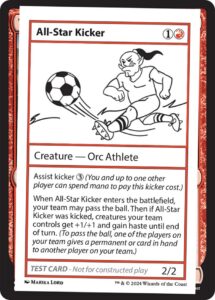
Aside from the Eldraine-worthy wordplay in this card’s name, it is a rather poignant reminder of formats like Two-Headed Giant, and thus of how Battlebond is an underappreciated set. I understand that there are good reasons why Commander is the most popular format. I will never tell anyone that their favorite format is illegitimate, whether it’s Commander or something else. (Unless it involves playing for ante. If you can’t see that that always ends in tears, there’s one particular Peanuts special you’ll need to watch.) What I will tell you is that I know what it’s like to play Magic in an era when there’s considered to be just one universal or correct way to play. I have seen how it narrows minds, cuts off potential fun experiences, and causes people to mis-perceive cards as useless when they’re actually contextual. I experienced this in the 2000s when many people thought that Pro Tour play was the pinnacle of Magic. I will always warn against something similar happening again, even if it’s a “social” format.
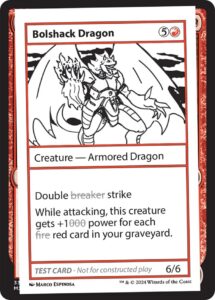
This card is another reference to a different TCG, in this case Duel Masters. The playtest card is a near piece-by-piece reconstruction of a card with the same name, hence the text adjustments. I’ve never played Duel Masters, but judging by this card, it clearly has a lot of mechanical parallels with Magic. This is not unusual: I’ve played a little bit of Sorcery: Contested Realm and Star Wars Unlimited, both of which lifted a lot of mechanics and gameplay practices directly from Magic. It’s a tribute to everything Magic does right, and it gives us some reassurance that there’s a solid base with which to make Magic even better. Of course, the real big innovations might have to come from competitive pressure (in the market sense), and neither Sorcery nor Star Wars Unlimited is yet at a scale where they could exert such pressure on Hasbro. There’s a strong argument that if you really want Wizards of the Coast to do better, one facet of that should be hoping that games like Star Wars Unlimited take off.
I’m actually glad they’ve finally started reducing the average power stat for creatures with first strike and double strike. In combat-centric settings, even a single one can take over a table, especially on defense. It gets even worse when you can disrupt the opponent’s ability to go wide around your first strikers with a card like Thalia, Heretic Cathar, or counter any non-creature answers they might have. There have already been too many Magic card designs and metagames that favored defense unduly.
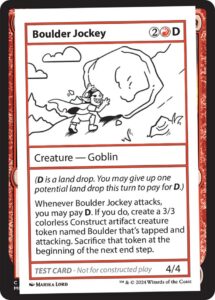
I have to confess to once trying to play Rock Jockey in a constructed deck. It went about as well as you can imagine. Having said that, Scourge was years before cards like Explore and Courser of Kruphix, and there could actually be some room to get cute with giving up land plays nowadays. It also occurs to me that Sligh-style red decks don’t have much use for lands late in the game, and you could give up land plays turn after turn while holding back Mountains that your opponent has to worry might be burn spells. This idea involves more tracking than it seems – a lot of people forget whether they’ve played a land on their current turn when a lot is going on. But it also has more potential than it seems.
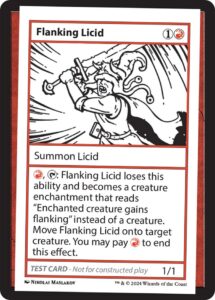
This is the kind of design that a certain audience liked about Time Spiral and Modern Horizons – combinations of mechanics that never went together in mainline sets, usually wrapped up in a historical reference of some kind. I like them in principle and enjoy looking at them and reminiscing, but as I get older, I feel they don’t always make for good gameplay. As I alluded to in my last Mystery Booster article, there’s something nice about the emergent complexity of individually elegant cards.
Flanking isn’t too bad in and of itself, with the main issue being that people sometimes get tripped up by the fact that it checks whether the blocking creature has flanking. On the other hand, the licid ability is basically held together with Scotch tape and collective willpower. It works well in casual play as long as nobody at the table analyzes it too much. I think Flanking Licid could be fun for kitchen table decks, although flanking is a little obscure and perhaps not very high-impact in many casual settings.
This is based on a card used in the 1998 Invitational tournament, where the players played a draft event that used playtest cards. Some were experimental designs like Flanking Licid, and some were surprisingly close to mainline cards – in other words, they were very much like the bonus cards in Mystery Booster. Mark Rosewater posted a list of them on Twitter / X / whatever it’s called now, and if you have time to look through them, you’ll find some that are eerily familiar to us in 2025.
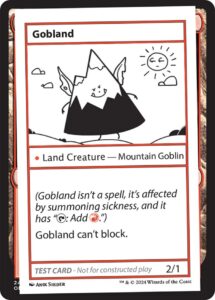
I feel oddly favorable towards this particular land, although that might just be because the art is very cute. Sadly, I don’t know how likely it is they’ll lean into land creatures of this particular style, because of the problems that were caused by Dryad Arbor. Despite its printings generally being plastered with various reminders and indicators, some players still found it confusing as to just what they could and couldn’t do with it. Lands can tap the turn you play them, but creatures generally can’t; for some reason, the creature quality takes precedence with Dryad Arbor (and Gobland) and it’s not entirely clear why. The trick where you can tutor a Dryad Arbor with Green Sun’s Zenith on X=0 feels like cheating the first time you see it, and some people confuse themselves further by putting the card among their lands and forgetting it’s there.
And, of course, there was a (in)famous tournament incident involving that practice. Did you notice from that link above that there’s one version of Dryad Arbor that has no text at all, and looks like a Forest from across the table? A player at a high-level tournament once had that version next to his other lands, his opponent missed it, and miscalculated an attack because he didn’t realize that there was an additional blocker. While you do have to look at both sides of the table in big events, I am not at all convinced that the Dryad Arbor player did this innocently. He reached right for it, after all. And yet Cheatyface is not allowed in tournaments.
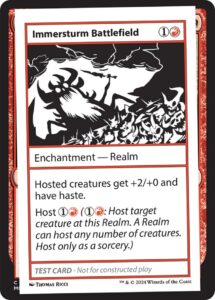
All-Star Kicker is a poignant reminder of Two-Headed Giant, and Immersturm Battlefield does the same thing for Planechase. I recently completed my collection of the new planes they made for March of the Machine‘s Commander decks, and not only are they fun to use as intended, they also make me long to visit new worlds in future Magic sets. Ten Wizards Mountain particularly speaks to me – and there would be so much to look at in a Theros-style set that drew on Chinese myth and legend.
I am extremely impressed how much detail Immersturm Battlefield’s art manages to have, when it’s drawn in such a simple style. The Mystery Booster playtest cards show that it’s possible to make visual appeal using this and related styles in a moderately-sized group of cards; they might be reluctant to illustrate a whole mainline set like that, but maybe a Secret Lair or even a Commander deck? I kind of want to see them try that, too.
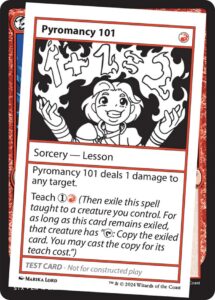
There are so many things to like about this card. It portrays Chandra in her Novice Pyromancer/Acolyte of Flame era from M20, which have become my favorite versions of her in the past few years. It absolutely nails the flavor of teaching a spell, to the point where I hope they use it in the new Strixhaven set next year. I’ve seen the Storm Scale ratings for cipher and haunt, but it’d feel hypocritical of them to rule it out after Stormscale Scion. And last but not least, it’s a reminder of how Lessons are cool on their own, and how the design conceit of instant and sorcery subtypes is vastly underused. Six over the course of 30 years doesn’t feel like a lot for a game named “Magic”.
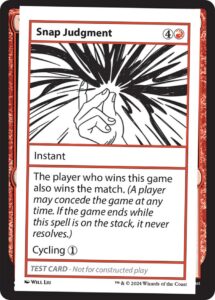
Like a lot of Un-cards, Snap Judgment causes a huge mental shock when you read it, and it takes some time to work through the possibilities. It’s really a minigame card of sorts, because you’re essentially placing a bet about whether or not you can win the game you’re currently playing. Arguably more than that, it’s a psychological weapon. Consider that most multiple-game matches have three games. By casting it, you’re not only saying that you have a ridiculous amount of guts and/or are reckless, you’re implying that you’re either the best player ever and can turn any situation into a win, or you have some big surprise in your deck that you don’t think your opponent can deal with. And not everyone has the guts to risk that against a person who’s cast Snap Judgment in the first game. These are the case when it’s cast in the second game of a match – but even more so in the first game, when you have more to lose if you’re wrong. Given how conservative Magic strategy tends to be, I’m guessing a lot of people would say that given a comparatively even table state, the strategy against a game one Snap Judgment is to concede before it resolves and try and come back in game two. And further, I suspect there would in turn be a subset of advice relating to ways you can present your deck to either look more powerful than it is, or present yourself as the type of person who intimidates the average tournament player.
Now that I’ve written that out, I’m starting to dislike the card. It reminds me that I just saw someone on Instagram post a screenshot from a competitive EDH subreddit. It showed somebody asking for advice on gaslighting and manipulating opponents (their words, not mine) into making mistakes and/or throwing the game. I have no problem with bluffing. I have no problem with gameplay-related tricks. I have a problem with acting like a sociopath for the purpose of winning a Tarkir: Dragonstorm Play Booster, and too many people would interpret a card like Snap Judgment as an invitation to do exactly that.
I know that was long, but red is after all the color of creativity, and it gets my words flowing. Next time out, we’ll do green!

